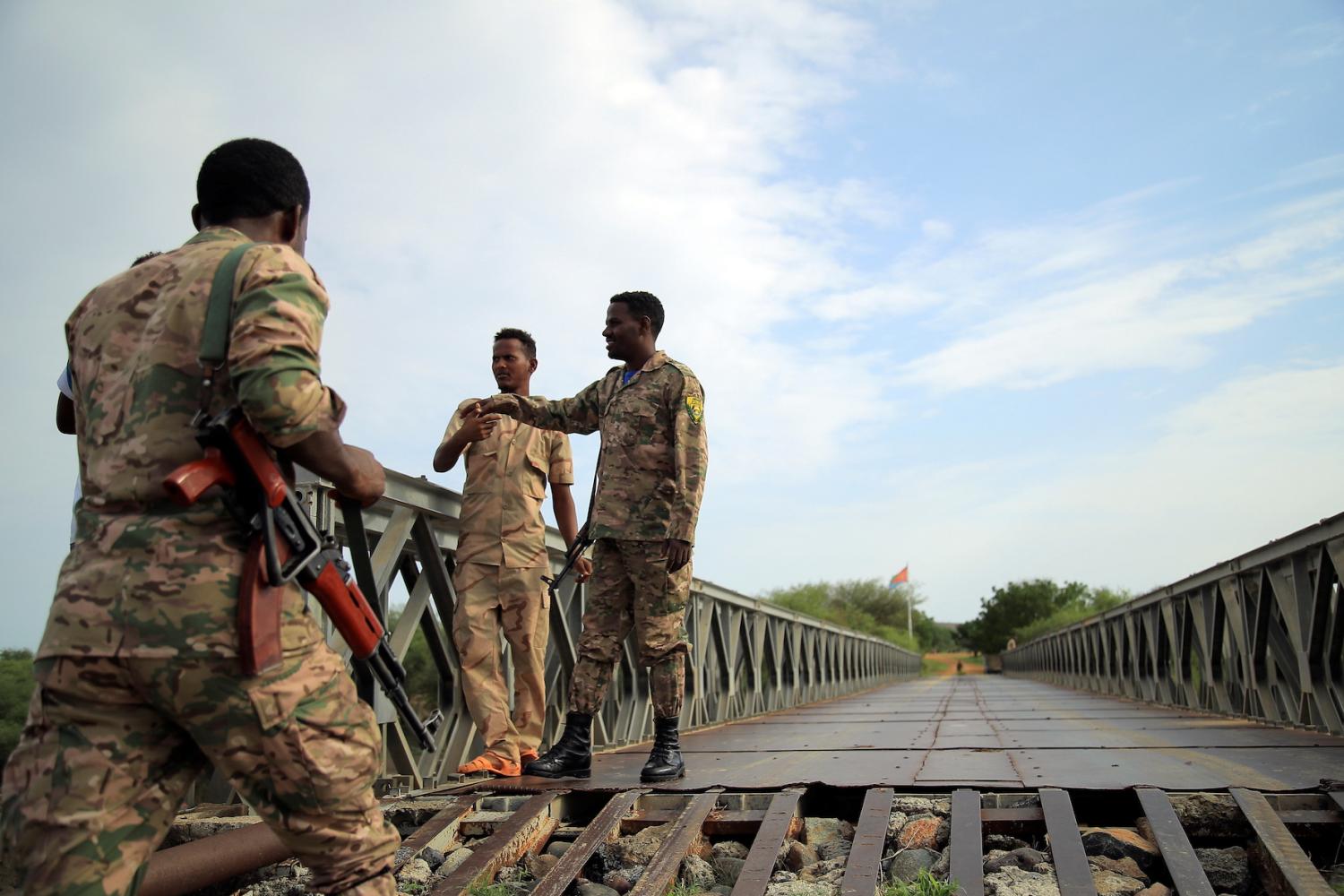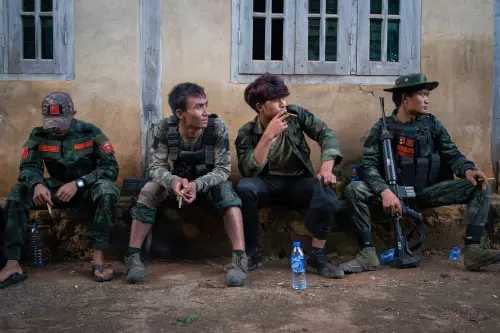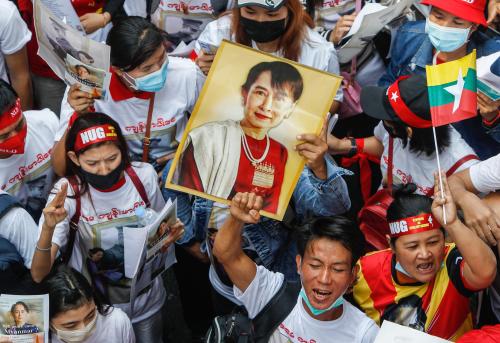This piece is part of a series titled “Nonstate armed actors and illicit economies in 2024” from Brookings’s Initiative on Nonstate Armed Actors.
Despite military conflict persisting across large swaths of Myanmar in 2024, the ruling military junta will retain firm control of the major population centers — namely, Yangon, Naypyidaw, and Mandalay. The kaleidoscopic patchwork of resistance groups currently does not demonstrate the capacity to displace the military from these major urban centers, especially without significant and unlikely external support. While control of many areas in the country is contested, the regime does not actually need to control the entire country to “win” — it hasn’t fully controlled the country since its independence.
While Myanmar is no stranger to conflict, often referred to as the world’s longest-running civil war, the current fighting is unique in its intensity and the spread of violence to Bamar ethnic regions. The risk of regional escalation remains very low without unlikely expansion into a full proxy war by foreign powers.
However, the conflict in Myanmar sits at a dynamic nexus of U.S. and Western foreign policy priorities, and objectives there will remain complicated by both friendly nations and adversaries that have significant stakes in the conflict’s dynamics and outcome.
The fragmented internal environment
The governing junta, the State Administration Council (SAC), led by de facto dictator Min Aung Hlaing, also the commander-in-chief of the military, continues to delay democratic elections in violation of the state constitution while dismantling political opposition.
The most externally visible member of the opposition, the National Unity Government (NUG), attempts to shadow govern from exile. It has secured some Western backing — including formal recognition by the European Parliament — although no country has formally recognized it as Myanmar’s legitimate government or provided any military or significant financial support. However, internal to Myanmar, the powerful Ethnic Armed Organizations (EAOs) still provide the most significant power and influence behind the resistance. Thus, the mutual support between the NUG and the most powerful EAOs is critical to maintaining pressure on the junta. Yet, even within this construct, some EAOs view the ongoing conflict as an opportunity to expand their territory and influence versus an altruistic struggle for democracy.
Despite some proclamations at the end of 2023 of a tide-turning momentum shift based on the surprising success of Operation 1027 in Shan State, Myanmar’s armed resistance is not a monolithic and homogenous nationwide “movement” with a single leader, unified command and control, and coordinated operations. As it has been since the 1960s, it remains an array of groups with varying alliances, loyalties, military capabilities, and objectives, albeit with a common enemy.
The two main categories of resistance groups are the EAOs, some of which have been battling the military for decades, and the People’s Defense Forces (PDFs), which emerged after the 2021 coup. EAO interests and priorities focus on autonomy for their ethnic groups. Many of the larger EAOs function as sub-state governing entities, not just guerilla armies. The largest and most powerful EAOs, such as the Kachin Independence Organization and the Karen National Union, provide administration services such as schools, healthcare systems, public works infrastructure, and defense.
The separate, but not always distinct, PDFs have developed into a complex Venn diagram of overlapping affiliations, command and control structures, and support networks. Some PDFs directly fall under the NUG’s command and support, while others are aligned under EAOs, and still others operate independently and, in some reported cases, have been accused of extrajudicial killings and other abuses. Additionally complicating the landscape, PDFs in EAO border regions often share oversight from NUG and EAO leadership — highlighting that the powerful EAOs remain the country’s true power brokers.
Importantly, PDFs conduct most of the combat operations in major urban areas and Bamar regions, where historically the military has not faced significant armed opposition. Thus, they open additional battlefield fronts that strain the military’s operational and logistical infrastructure and impact morale.
But the resistance groups still lack the military capability and hardware to fight at scale in major population centers where the regime has deployed significant layered defenses of sophisticated conventional forces and expansive intelligence networks. To dislodge the regime, the resistance would require significant external funding, training, and military equipment. Nationwide coordination of these capabilities would be required for a simultaneous and unified strategic campaign capable of overwhelming the military.
The lack of unity and cohesion in the resistance groups’ command structures and coordination underscores an already-nonexistent foreign willingness to become militarily involved. It complicates how any foreign military support could be distributed effectively without causing additional instability and infighting between the groups. Difficult logistics further complicate any foreign military support: neither Thailand nor India, whose territory and land routes would be crucial for the scale of military support required, is highly unlikely to lend any support or approval to such activities. In fact, they are both increasing their engagement with the junta.
The fractured external environment
Foreign actors in Myanmar also have varying degrees of alignment, with several openly opposing Western objectives.
China’s role in Myanmar is often mischaracterized and oversimplified. Erroneously, the Myanmar regime is described as being very close to China by choice, while China is said to wield such influence that Myanmar is essentially its proxy state. In reality, China’s outsized role in Myanmar mostly stems from its geographic proximity and power preponderance, instead of an alignment of values or interests. Despite the regime and population’s resentments vis-à-vis China, Myanmar’s international pariah status drives it to accept China’s support and influence.
Beijing’s overriding priority in Myanmar is maintaining stability, especially in regions bordering China. China has long been known to “play both sides” of the conflict in Myanmar — providing military and economic aid to the ruling government, while also supporting numerous EAOs, including the largest and most militarily powerful EAO, the United Wa State Army, which is widely seen as a proxy of China’s People’s Liberation Army.
Russia’s relationship with Myanmar is much more transactional, with Russia significantly increasing its ties with the regime since the 2021 coup. Three of Min Aung Hlaing’s overseas trips since the coup have been to Russia. Sharing an international pariah status, Russia and Myanmar have signed multiple agreements — from tourism, media, and education exchanges to increased military ties and nuclear power development. Direct military support includes Russia’s delivery of Su-30 fighter jets and counterinsurgency training and advising. Russia has been able to support the junta despite the war in Ukraine constraining its assistance capacities. The junta likely sees closer ties with Russia as a hedge against overdependence on China.
Russia and China’s policies are clearly adversarial toward Western interests in Myanmar. However, Thailand, an essential regional U.S. ally, and India, a critical U.S. regional partner and member, along with the United States, of the Quad, also complicate Western policymaking. Unlike the Western hardline anti-regime stance, Thailand and India must balance democratic values against geographic realities.
Both bilaterally and within the Association of Southeastern Asian Nations, Thailand has begun normalizing its engagement with the Myanmar regime in trade, energy, humanitarian assistance, and even military cooperation. Hosting the majority of Myanmar’s refugees is straining Thailand’s resources and humanitarian networks, and Bangkok is concerned that the ongoing fighting in eastern Myanmar could spill into western Thailand. Economic interests are also a factor: For example, recently imposed U.S. sanctions against the regime-controlled Myanma Oil and Gas Enterprise (MOGE) pose a direct negative impact on Thailand’s own state oil company, PTT, which owns a controlling stake in some of MOGE’s largest oil and gas fields. It is because of these negative impacts on Thailand, as well as on some U.S. companies, that MOGE sanctions have been delayed for so long, despite being one of the most called-for sanctions targets by regime opposition groups. The United States specifically structured the sanctions to maximize the impact on the regime, while minimizing the impact on Thailand.
With its top priorities to counter Chinese influence in its backyard and growing instability and humanitarian crises along the India-Myanmar border, India too has moved toward normalizing relations with the junta. India is particularly concerned with the maritime realm and China’s construction of the Kyaukpyu Port in western Myanmar, among other activities. The port provides Chinese naval vessels with access to the Indian Ocean and is near one of India’s most strategic naval bases.
The resiliency of Myanmar’s junta
Although resistance groups have periodically made significant gains against the regime’s military, it would be premature and unwise to predict a nationwide collapse of the regime based on essentially idiosyncratic circumstances. For decades, the regime’s military has proved to be resilient and cunningly effective, if highly brutal, in maintaining power.
Ultimately, both the junta and the resistance groups view the fight as an existential conflict. Resistance constituencies have decried talks of negotiations as submitting to the junta. Although regularly negotiating with EAOs, the junta has adamantly refused to negotiate with the NUG, labeling it a terrorist group.
Yet in the foreseeable future, neither side will have the military capability to decisively seize contested areas and “win.” Nevertheless, for the regime, “winning” requires only maintaining control of the major population centers and outlasting the resistance. Without significant, but unlikely, external military and financial support for the resistance, the conflict will drag on in ebbs and flows of momentum without truly threatening the military’s core power centers, thereby extending human suffering and impeding the country from reestablishing democratic civilian rule.
The conclusions and opinions expressed in this article are those of the author and do not necessarily reflect the official policy or position of the U.S. government, Department of Defense, or the U.S. Air Force.
The Brookings Institution is committed to quality, independence, and impact.
We are supported by a diverse array of funders. In line with our values and policies, each Brookings publication represents the sole views of its author(s).







Commentary
Myanmar’s junta doesn’t have to ‘win,’ it just has to wait
January 24, 2024